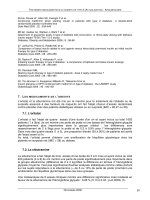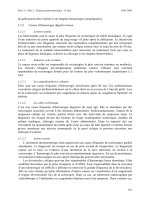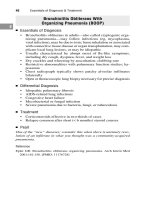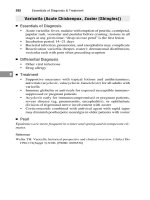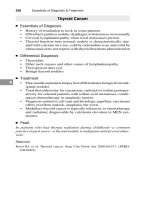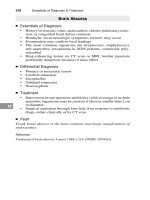DIAGNOSIS & TREATMENT - PART 6 potx
Bạn đang xem bản rút gọn của tài liệu. Xem và tải ngay bản đầy đủ của tài liệu tại đây (469.95 KB, 54 trang )
Thyroid Cancer
■
Essentials of Diagnosis
• History of irradiation to neck in some patients
• Often hard, painless nodule; dysphagia or hoarseness occasionally
• Cervical lymphadenopathy when local metastases present
• Thyroid function tests normal; nodule is characteristically stip-
pled with calcium on x-ray, cold by radioiodine scan, and solid by
ultrasound; does not regress with thyroid hormone administration
■
Differential Diagnosis
• Thyroiditis
• Other neck masses and other causes of lymphadenopathy
• Thyroglossal duct cyst
• Benign thyroid nodules
■
Treatment
• Fine-needle aspiration biopsy best differentiates benign from mal-
ignant nodules
• Total thyroidectomy for carcinoma; radioactive iodine postoper-
atively for selected patients with iodine-avid metastases; combi-
nation chemotherapy in anaplastic tumors
• Prognosis related to cell type and histology; papillary carcinoma
offers excellent outlook, anaplastic the worst
• Medullary thyroid cancer is typically refractory to chemotherapy
and radiation; diagnosable by calcitonin elevation in MEN syn-
dromes
■
Pearl
In patients who had thymus radiation during childhood—a common
practice in past years—a thyroid nodule is malignant until proved other-
wise.
Reference
Rossi RL et al: Thyroid cancer. Surg Clin North Am 2000;80:571. [PMID:
10836007]
256 Essentials of Diagnosis & Treatment
9
Carcinoma of the Prostate
■
Essentials of Diagnosis
• More common and seemingly more aggressive in blacks
• Exact role of screening uncertain; may prove to be more useful in
middle-aged men, especially blacks
• Symptoms of prostatism more often absent than present; bone
pain (especially back) if metastases present; asymptomatic in
many, however
• Stony, hard, irregular prostate palpable, usually lateral part of
gland
• Osteoblastic osseous metastases visible by plain radiograph
• Prostate-specific antigen (PSA) is age-dependent and is elevated
in older patients with benign prostatic hyperplasia and also acute
prostatitis; reliably predicts extent of neoplastic disease and
recurrence after prostatectomy
■
Differential Diagnosis
• Benign prostatic hyperplasia (may be associated)
• Scarring secondary due to tuberculosis or calculi
• Urethral stricture
• Neurogenic bladder
■
Treatment
• Providers must apprise patients of the probability of post-
therapeutic erectile dysfunction, urinary incontinence
• Radiation therapy (external beam, brachytherapy, or combina-
tion) or radical prostatectomy, ideally nerve-sparing for local-
ized disease
• Radiation or surgical therapy for local nodal metastases in selected
patients after prostatectomy
• Androgen ablation (chemical or surgical) for metastatic disease,
though exact timing of initiation of therapy (at diagnosis or at
onset of symptoms) is unclear
• Combination chemotherapy may benefit selected patients with
hormone-refractory metastatic disease
■
Pearl
About 1% of prostate tumors—most of these are small-cell carcinomas—
are not adenocarcinoma and thus do not express PSA.
Reference
Klotz L: Hormone therapy for patients with prostate carcinoma. Cancer
2000;88(12 Suppl):3009. [PMID: 10898345]
Chapter 9 Oncologic Diseases 257
9
Tumors of the Testis
■
Essentials of Diagnosis
• Painless testicular nodule; peak incidence at age 20–35
• Testis does not transilluminate
• Gynecomastia, premature virilization in occasional patients
• Tumor markers (AFP, LDH, hCG) useful in diagnosis, monitor-
ing response to therapy, and surveillance for relapse
• Pure seminoma produces hCG only, while nonseminomatous
germ cell tumors may produce hCG and AFP
■
Differential Diagnosis
• Genitourinary tuberculosis
• Syphilitic orchitis
• Hydrocele
• Spermatocele
• Epididymitis
■
Treatment
• Orchiectomy, with lumbar and inguinal lymph nodes examined
for staging
• Additional radical resection of iliolumbar nodes indicated unless
tumor is a seminoma for which radiation therapy is treatment of
choice following surgery
• Postsurgical radiation therapy also useful for other malignant cell
types
• Platinum-based chemotherapy curative in appreciable majority of
patients with advanced or metastatic disease
■
Pearl
One of the great stories in oncology, with remarkable therapies result-
ing in many years of life saved.
Reference
Kinkade S: Testicular cancer. Am Fam Physician 1999;59:2539. [PMID:
10323360]
258 Essentials of Diagnosis & Treatment
9
Carcinoma of the Bladder
(Transitional Cell Carcinoma)
■
Essentials of Diagnosis
• More common in men over 40 years of age; predisposing factors
include smoking and alcohol as well as chronic Schistosoma
haematobium infection, exposure to certain industrial toxins, or
previous cyclophosphamide therapy
• Microscopic or gross hematuria with no other symptoms is the
most common presentation
• Suprapubic pain, urgency, and frequency when concurrent infec-
tion present
• Occasional uremia if both ureterovesical orifices obstructed
• Tumor visible by cystoscopy
■
Differential Diagnosis
• Other urinary tract tumor
• Acute cystitis
• Renal tuberculosis
• Urinary calculi
• Glomerulonephritis or interstitial nephritis
■
Treatment
• Endoscopic transurethral resection for superficial or submucosal
tumors; intravesical chemotherapy reduces the likelihood of re-
currence
• Radical cystectomy standard with muscle-invasive tumors, though
less morbid procedures with intensive follow-up may provide sim-
ilar outcomes
• Role of adjuvant chemotherapy or radiation for completely re-
sected patients unclear, but generally offered to those at high risk
of recurrence
• Combination chemotherapy for metastatic disease has a high re-
sponse rate and may be curative in a small percentage of patients
■
Pearl
Remember Kaposi’s sarcoma of the bladder in an AIDS patient with a
urinary catheter and gross hematuria; it usually (not always) presents
in association with cutaneous disease.
Reference
van der Meijden AP: Bladder cancer. BMJ 1998;317:1366. [PMID: 99030215]
Chapter 9 Oncologic Diseases 259
9
Adenocarcinoma of the Kidney
(Renal Cell Carcinoma; Hypernephroma)
■
Essentials of Diagnosis
• Dubbed the internist’s tumor because of its pleomorphic clinical
manifestations
• Gross or microscopic hematuria, back pain, fever, weight loss,
night sweats
• Flank or abdominal mass may be palpable
• When flank pain, hematuria, and palpable mass—the “too-late
triad”—are present, only 15% are curable
• Anemia in 30%, erythrocytosis in 3%; hypercalcemia, hypo-
glycemia sometimes seen
• Frequent tumor or tumor thrombus invasion of renal vein and
ascending inferior vena cava, on occasion causing superior vena
cava syndrome
• Renal ultrasound, CT, or MRI reveals characteristic lesion
■
Differential Diagnosis
• Simple cyst
• Polycystic kidney disease
• Single complex renal cyst; but 70% of these are malignant
• Renal tuberculosis
• Renal calculi
• Renal infarction
• Endocarditis
■
Treatment
• Nephrectomy curative for patients with early stage lesions
• Poor response to chemotherapy or radiation in metastatic disease
• Small response rate to combination bio-chemotherapy (inter-
leukin 2 plus cytotoxic agents), though very toxic
• Resection of primary lesion has been documented to result in
regression of metastases on rare occasions
• Nonmyeloablating allogeneic bone marrow transplantation has
significant response rate in highly selected patients
■
Pearl
A small proportion of patients have a nonmetastatic hepatopathy, with
elevation of alkaline phosphatase; this abnormality does not imply in-
operability and disappears with resection of the tumor.
Reference
Motzer RJ et al: Renal-cell carcinoma. N Engl J Med 1996;335:865. [PMID:
8778606]
260 Essentials of Diagnosis & Treatment
9
Malignant Tumors of the Esophagus
■
Essentials of Diagnosis
• Progressive dysphagia—initially during ingestion of solid foods,
later with liquids; progressive weight loss and inanition ominous
• Smoking, alcoholism, chronic esophageal reflux with Barrett’s
esophagus, achalasia, caustic injury, and asbestos are risk factors
• Noninvasive imaging (barium swallow, CT scan) suggestive,
diagnosis confirmed by endoscopy and biopsy
• Staging of disease aided by endoscopic ultrasound
• Squamous histology more common, though incidence of adeno-
carcinoma increasing rapidly in Western countries for unclear
reasons
■
Differential Diagnosis
• Benign tumors of the esophagus
• Benign esophageal stricture or achalasia
• Esophageal diverticulum
• Esophageal webs
• Achalasia (may be associated)
• Globus hystericus
■
Treatment
• Combination chemotherapy and radiotherapy or surgery for lo-
calized disease, though long-term remission or cure is achieved
in only 10–15%
• Dilation or esophageal stenting may palliate advanced disease;
little role for chemotherapy or radiation in advanced or metasta-
tic disease
■
Pearl
Dysphagia is one of the few symptoms in medicine for which anatomic
correlation always exists—too often it represents carcinoma.
Reference
Lerut T et al: Treatment of esophageal carcinoma. Chest 1999;116(6
Suppl):463S. [PMID: 10619509]
Chapter 9 Oncologic Diseases 261
9
Carcinoma of the Stomach
■
Essentials of Diagnosis
• Few early symptoms, but abdominal pain not unusual; late com-
plaints include dyspepsia, anorexia, nausea, early satiety, weight
loss
• Palpable abdominal mass (late)
• Iron deficiency anemia, fecal occult blood positive; achlorhydria
present in minority of patients
• Mass or ulcer visualized radiographically; endoscopic biopsy and
cytologic examination diagnostic
• Associated with atrophic gastritis, Helicobacter pylori; role of
diet, previous partial gastrectomy controversial
■
Differential Diagnosis
• Benign gastric ulcer
• Gastritis
• Functional or irritable bowel syndrome
• Other gastric tumors, eg, leiomyosarcoma, lymphoma
■
Treatment
• Resection for cure; palliative resection with gastroenterostomy in
selected cases
• Adjuvant chemotherapy may improve long-term survival in high-
risk patients post surgery and may achieve remission in a minor-
ity of patients with metastatic disease
■
Pearl
A gastric ulcer with histamine-fast achlorhydria is adenocarcinoma in
100% of cases.
Reference
Scheiman JM et al: Helicobacter pylori and gastric cancer. Am J Med
1999;106:222. [PMID: 10230753]
262 Essentials of Diagnosis & Treatment
9
Bronchogenic Carcinoma
■
Essentials of Diagnosis
• Smoking most important cause, concomitant asbestos exposure
synergistic; also associated with second-hand smoke
• Chronic cough, dyspnea; chest pain, hoarseness, hemoptysis,
weight loss; may be asymptomatic, however
• Examination depends on disease stage; localized wheezing, club-
bing, superior vena cava syndrome in some
• Enlarging mass, infiltrate, atelectasis, pleural effusion, or cavita-
tion by chest x-ray; peripheral coin lesions in a minority
• Diagnostic: presence of malignant cells by sputum or pleural fluid
cytology or on histologic examination of tissue biopsy
• Metastases to other organs or paraneoplastic effects may produce
the initial symptoms
• Central nervous system metastases at time of diagnosis common
with small cell histology
■
Differential Diagnosis
• Tuberculosis
• Pulmonary mycoses
• Pyogenic lung abscess
• Metastasis from extrapulmonary primary tumor
• Benign lung tumor, eg, hamartoma
• Noninfectious granulomatous disease
■
Treatment
• Resection for appropriate non-small-cell carcinomas and all coin
lesions, assuming no evidence of spread or other primary
• Combination chemotherapy and radiation for limited-stage small-
cell carcinoma; may be curative
• Prophylactic cranial radiation probably beneficial for those achiev-
ing complete remission or excellent response with initial therapy
• Palliative chemotherapy and radiation for metastatic non-small-cell
carcinoma
■
Pearl
Of nonsmokers who develop this disorder, middle-aged women with
non-small cell cancer are the most common; take pulmonary symptoms
very seriously in this group.
Reference
Hoffman PC et al: Lung cancer. Lancet 2000;355:479. [PMID: 10841143]
Chapter 9 Oncologic Diseases 263
9
Pleural Mesothelioma
■
Essentials of Diagnosis
• Insidious dyspnea, nonpleuritic chest pain, weight loss
• Dullness to percussion, diminished breath sounds, pleural friction
rub, clubbing
• Nodular or irregular unilateral pleural thickening, often with ef-
fusion by chest radiograph; CT scan often helpful
• Pleural biopsy usually necessary for diagnosis, though malignant
nature of tumor only confirmed by natural history; pleural fluid
exudative and usually hemorrhagic
• Strong association with asbestos exposure, with usual latency
from time of exposure 20 years or more
■
Differential Diagnosis
• Primary pulmonary parenchymal malignancy
• Empyema
• Benign pleural inflammatory conditions (posttraumatic, asbestosis)
■
Treatment
• No consistently effective therapy currently available, though inves-
tigations with combination surgery, radiotherapy, and chemo-
therapy are under way
• One-year mortality rate > 75%
■
Pearl
Consider this when empyema develops in patients irradiated for malig-
nancy years earlier—it’s a rare complication.
Reference
Sterman DH et al: Advances in the treatment of malignant pleural mesothelioma.
Chest 1999;116:504. [PMID: 10453882]
264 Essentials of Diagnosis & Treatment
9
Primary Intracranial Tumors
■
Essentials of Diagnosis
• Many different cell types; prognosis upon which one; half are
gliomas
• Most present with generalized or focal disturbances of cerebral
function: generalized symptoms include nocturnal headache,
seizures, and projectile vomiting; focal deficits relate to location
of the tumor
• CT or MRI with gadolinium enhancement defines the lesion; pos-
terior fossa tumors are better visualized by MRI
• Biopsy is the definitive diagnostic procedure, distinguishes pri-
mary brain tumors from brain abscess and other intracranial space-
occupying lesions such as metastases
Specific types:
• Glioblastoma multiforme: in strictest sense an astrocytoma, but
rapidly progressive with a poor prognosis
• Astrocytoma: More chronic course than glioblastoma, with a
variable prognosis
• Medulloblastoma: seen primarily in children and arises from roof
of fourth ventricle
• Cerebellar hemangioblastoma: patients usually present with dis-
equilibrium and ataxia, and occasional erythrocytosis
• Meningioma: compresses rather than invades adjacent neural
structures; usually benign
• Primary cerebral lymphoma: usually in AIDS and other immun-
odeficient states, though may occur rarely in immunocompetent
individuals
■
Treatment
• Treatment depends upon the type and site of the tumor and the
condition of the patient
• Resection to maximal extent possible is important predictor of
outcome in most central nervous system malignancies
• Radiation post surgery is mainstay of therapy
• Herniation treated with intravenous corticosteroids, mannitol,
and surgical decompression if possible
• Prophylactic anticonvulsants are also commonly given
■
Pearl
A headache that awakens a patient from sleep should put this diagno-
sis at the top of the list.
Reference
DeAngelis LM: Brain tumors. N Engl J Med 2001;344:114. [PMID: 11150363]
Chapter 9 Oncologic Diseases 265
9
266
10
Fluid, Acid-Base,
& Electrolyte Disorders
Dehydration (Simple & Uncomplicated)
■
Essentials of Diagnosis
• Thirst, oliguria
• Decreased skin turgor, especially on anterior thigh; dry mucous
membrane, postural hypotension, tachycardia
• Impaired renal function (BUN to creatinine ratio > 20), elevated
urinary osmolality and specific gravity, decreased urinary sodium
(fractional excretion of sodium is usually < 1%)
■
Differential Diagnosis
• Hemorrhage
• Sepsis
• Gastrointestinal fluid losses
• Skin sodium losses associated with burns or sweating
• Renal sodium loss
• Adrenal insufficiency
• Nonketotic hyperosmolar state in type 2 diabetics
■
Treatment
• Identify source of volume loss if present
• Replete with normal saline, blood, or colloid as indicated
• Half-normal saline may be substituted when blood pressure nor-
malizes
■
Pearl
Dry mucous membranes are more indicative of mouth breathing than
of dehydration.
Reference
Kleiner SM: Water: an essential but overlooked nutrient. J Am Diet Assoc
1999;99:200. [PMID: 9972188]
Copyright 2002 The McGraw-Hill Companies, Inc. Click Here for Terms of Use.
Shock
■
Essentials of Diagnosis
• History of hemorrhage, myocardial infarction, sepsis, trauma, or
anaphylaxis
• Tachycardia, hypotension, hypothermia, tachypnea
• Cool, sweaty skin with pallor; may be warm or flushed, however,
with early sepsis; clouded sensorium, altered level of conscious-
ness, seizures
• Oliguria, increased urinary osmolality and specific gravity, ane-
mia, disseminated intravascular coagulation, metabolic acidosis
may complicate
• Hemodynamic measurements depend upon underlying cause
■
Differential Diagnosis
• Numerous causes of the syndrome, as noted above
• Adrenal insufficiency
■
Treatment
• Correct cause of shock (ie, control hemorrhage, treat infection,
correct metabolic disease)
• Empiric broad-spectrum antibiotics often necessary
• Restore hemodynamics with fluids; vasopressor medications may
be required
• Maintain urine output
• Treat contributing disease (eg, diabetes mellitus)
■
Pearl
The patient appearing to be in shock but who is hypertensive may have
aortic dissection.
Reference
Dabrowski GP et al: A critical assessment of endpoints of shock resuscitation.
Surg Clin North Am 2000;80:825. [PMID: 10897263]
Chapter 10 Fluid, Acid-Base, & Electrolyte Disorders 267
10
Hypernatremia
■
Essentials of Diagnosis
• Usually severe thirst unless mentation altered; oliguria
• If hypovolemic, loose skin with poor turgor, tachycardia, hypo-
tension
• Serum sodium > 145 meq/ L, serum osmolality > 300 meq/ L
caused by free water loss
• Affected patients usually include the very old, very young, criti-
cally ill, or neurologically impaired
■
Differential Diagnosis
• Diabetes insipidus, either idiopathic or drug-induced (eg, by
lithium)
• Loss of hypotonic fluid (insensible, diuretics, vomiting, diarrhea,
nasogastric suctioning)
• Salt intoxication
• Volume resuscitation and continuation of normal saline
(155 meq/L) after euvolemia achieved
■
Treatment
• Relatively rapid volume replacement followed by free water
replacement over 48–72 hours (beware of cerebral edema)
• Desmopressin acetate for central diabetes insipidus
■
Pearl
In-patient mortality for a sodium > 150 mg/dL is approximately 50%.
Reference
Adrogue HJ et al: Hypernatremia. N Engl J Med 2000;342:1493. [PMID:
10816188]
268 Essentials of Diagnosis & Treatment
10
Hyponatremia
■
Essentials of Diagnosis
• Nausea, headache, weakness, irritability, mental confusion (espe-
cially with serum sodium < 120 meq/L)
• Generalized seizures, lethargy, coma, respiratory arrest and death
may result
• Serum sodium < 130 meq/L; osmolality < 270 meq/L (hypotonic
hyponatremia); hypouricemia if SIADH or primary polydipsia is
the cause
■
Differential Diagnosis
• Hypovolemic causes (thiazide diuretics, osmotic diuresis, adrenal
insufficiency, vomiting, diarrhea, fluid sequestration or third-
spacing)
• Hypervolemic causes (congestive heart failure, cirrhosis, nephro-
tic syndrome, renal failure, pregnancy)
• Euvolemic causes (hypothyroidism, SIADH, adrenocortical insuf-
ficiency, reset osmostat, primary polydipsia)
• Hypertonic or isotonic hyponatremia (hyperglycemia, intravenous
mannitol)
• Pseudohyponatremia (hypertriglyceridemia, paraproteinemia):
laboratory artifact
■
Treatment
• Treat underlying disorder
• Corticosteroids empirically if adrenal insufficiency suspected
• Gradual correction (24–48 hours) of sodium unless severe central
nervous system signs present (beware of central pontine myeli-
nolysis)
• If hypovolemic, use saline
• If hypervolemic, use water restriction, diuretics, and normal saline
volume replacement of urine output
• Demeclocycline in selected patients with SIADH
■
Pearl
A sodium less than 130 mg/dL, BUN less than 10 mg/dL, and hypo-
uricemia in a patient without liver, heart, or kidney disease is virtually
diagnostic of SIADH.
Reference
Adrogue HJ et al: Hyponatremia. N Engl J Med 2000;342:1581. [PMID:
10824078]
Chapter 10 Fluid, Acid-Base, & Electrolyte Disorders 269
10
Hyperkalemia
■
Essentials of Diagnosis
• Weakness or flaccid paralysis, abdominal distention, diarrhea
• Serum potassium > 5 meq/L
• Electrocardiographic changes: peaked T waves, loss of P wave
with sinoventricular rhythm, QRS widening, ventricular asystole,
cardiac arrest
■
Differential Diagnosis
• Renal failure with oliguria
• Hypoaldosteronism (hyporeninism, potassium-sparing diuretics,
ACE inhibitors, adrenal disease, interstitial renal disease)
• Acidemia
• Burns, hemolysis
• Digitalis overdose
• Spurious from thrombocytosis, leukocytosis
■
Treatment
• Emergency (cardiac toxicity, paralysis): intravenous bicarbonate,
calcium gluconate, glucose, and insulin
• Dietary potassium restriction and sodium polystyrene sulfonate
or diuretic to lower body potassium subacutely
• Dialysis if oliguric renal failure or severe acidosis complicates
■
Pearl
A “junctional” rhythm in a patient with marked renal insufficiency is
in all likelihood sinus rhythm with failure of atrial depolarization.
Reference
Halperin ML et al: Potassium. Lancet 1998;352:135. [PMID: 98336038]
270 Essentials of Diagnosis & Treatment
10
Hypokalemia
■
Essentials of Diagnosis
• Usually asymptomatic
• Muscle weakness, lethargy, paresthesias, polyuria, anorexia, con-
stipation
• May progress to weakness, muscle necrosis, ascending flaccid
paralysis, ileus
• Electrocardiographic changes: T wave flattening and ST depres-
sion → development of prominent u waves → AV block → car-
diac arrest
• Serum potassium < 3.5 meq/L; metabolic alkalosis sometimes
concurrent
■
Differential Diagnosis/Causes
• Diuretic use
• Alkalemia
• Hyperaldosteronism (adrenal adenoma, primary hyperreninism,
mineralocorticoid use, and European licorice ingestion)
• Magnesium depletion
• Hyperthyroidism
• Diarrhea
• Renal tubular acidosis (types I, II)
• Bartter’s, Gitelman’s, and Liddle’s syndromes
• Familial hypokalemic periodic paralysis
• Severe dietary potassium restriction
■
Treatment
• Identify and treat underlying cause
• Oral or intravenous potassium supplementation
■
Pearl
Think of hypokalemia in unexplained orthostatic hypotension.
Reference
Cohn JN et al: New guidelines for potassium replacement in clinical practice: a
contemporary review by the National Council on Potassium in Clinical Prac-
tice. Arch Intern Med 2000;160:2429. [PMID: 10979053]
Chapter 10 Fluid, Acid-Base, & Electrolyte Disorders 271
10
Hypercalcemia
■
Essentials of Diagnosis
• Polyuria and constipation; abdominal pain in some
• Thirst and dehydration
• Mild hypertension
• Altered mentation, hyporeflexia, stupor, coma
• Serum calcium > 10.2 mg/dL (corrected with concurrent serum
albumin)
• Renal insufficiency or azotemia, isosthenuria
• Shortened QT interval due to short ST segment, ventricular extra-
systoles
■
Differential Diagnosis
• Primary hyperparathyroidism
• Adrenal insufficiency
• Malignancy (multiple myeloma with osteoclast-activating factor;
other primary tumor or metastasis releasing parathyroid hormone-
related peptide)
• Vitamin D intoxication
• Milk-alkali syndrome
• Sarcoidosis
• Tuberculosis
• Paget’s disease of bone, especially with immobilization
• Familial hypocalciuric hypercalcemia
■
Treatment
• Identify and treat underlying disorder
• Volume expansion, loop diuretics (once euvolemic)
• Glucocorticoids, calcitonin, bisphosphonates, and dialysis all use-
ful in certain instances
• Resection of parathyroid adenoma, if present
■
Pearl
All hypercalcemia of malignancy is humoral in origin; bone metastases
not elaborating such humoral factors do not elevate calcium.
Reference
Body JJ: Current and future directions in medical therapy: hypercalcemia. Can-
cer, 2000;88(12 Suppl):3054. [PMID: 10898351]
272 Essentials of Diagnosis & Treatment
10
Hypocalcemia
■
Essentials of Diagnosis
• Abdominal and muscle cramps, stridor; tetany and seizures
• Diplopia, facial paresthesias
• Positive Chvostek and Trousseau signs
• Cataracts if chronic, likewise basal ganglion calcifications
• Serum calcium < 8.5 mg/dL (corrected with concurrent serum
albumin); phosphate usually elevated; hypomagnesemia may
cause or complicate
• Electrocardiographic changes: prolonged QT interval; ventricu-
lar arrhythmias, including ventricular tachycardia
■
Differential Diagnosis
• Vitamin D deficiency and osteomalacia
• Malabsorption
• Hypoparathyroidism
• Hyperphosphatemia
• Hypomagnesemia
• Chronic renal failure
• Alcoholism
• Drugs (loop diuretics, aminoglycosides, foscarnet)
■
Treatment
• Identify and treat underlying disorder
• For tetany, seizures, or arrhythmias, give calcium gluconate
intravenously
• Magnesium replacement if indicated
• Oral calcium and vitamin D supplements
• Phosphate-binding antacids if phosphate elevated
■
Pearl
The prolonged QT of hypocalcemia results from a lengthened ST seg-
ment; T waves are normal.
Reference
Reber PM et al: Hypocalcemic emergencies. Med Clin North Am 1995;79:
93. [PMID: 7808098]
Chapter 10 Fluid, Acid-Base, & Electrolyte Disorders 273
10
Hyperphosphatemia
■
Essentials of Diagnosis
• Few distinct symptoms
• Cataracts, basal ganglion calcifications in hypoparathyroidism
• Serum phosphate > 5 mg/dL; renal failure, hypocalcemia occa-
sionally seen
■
Differential Diagnosis
• Renal failure
• Hypoparathyroidism
• Excess phosphate intake, vitamin D toxicity
• Phosphate-containing laxative use
• Cell destruction, rhabdomyolysis, respiratory or metabolic aci-
dosis
• Multiple myeloma
■
Treatment
• Treat underlying disease when possible
• Oral calcium carbonate to reduce phosphate absorption
• Hemodialysis if refractory
■
Pearl
Overshoot hyperphosphatemia from therapy of hypophosphatemia may
precipitate the acute onset of tetany.
Reference
Weisinger JR et al: Magnesium and phosphorus. Lancet, 1998;352:391. [PMID:
9717944]
274 Essentials of Diagnosis & Treatment
10
Hypophosphatemia
■
Essentials of Diagnosis
• Seldom an isolated abnormality
• Anorexia, myopathy, arthralgias
• Irritability, confusion, seizures, coma
• Rhabdomyolysis if severe
• Serum phosphate < 2.5 mg/dL, severe < 1 mg/dL; elevated crea-
tine kinase if rhabdomyolysis
• Hemolysis in severe cases
■
Differential Diagnosis
• Hyperparathyroidism, hyperthyroidism
• Alcoholism
• Vitamin D-resistant osteomalacia
• Malabsorption, starvation
• Hypercalcemia, hypomagnesemia
• Correction of hyperglycemia
• Recovery from catabolic state
■
Treatment
• Intravenous phosphate replacement when severe
• Oral phosphate supplements (unless hypercalcemic); be cautious
about overshooting
• Correct magnesium deficit, if present
■
Pearl
Phosphate levels even as low as 0–0.1 mg/dL are possible without clin-
ical manifestations.
Reference
Subramanian R et al: Severe hypophosphatemia. Pathophysiologic implications,
clinical presentations, and treatment. Medicine 2000;79:1. [PMID: 10670405]
Chapter 10 Fluid, Acid-Base, & Electrolyte Disorders 275
10
Hypermagnesemia
■
Essentials of Diagnosis
• Weakness, hyporeflexia, respiratory muscle paralysis
• Confusion, altered mentation
• Serum magnesium > 3 mg/dL; renal insufficiency common; in-
creased uric acid, phosphate, potassium, and decreased calcium
may be seen
• Increased PR interval → heart block → cardiac arrest
■
Differential Diagnosis
• Renal insufficiency
• Excessive magnesium intake (food, antacids, laxatives, intrave-
nous administration)
■
Treatment
• Correct renal insufficiency, if possible (volume expansion)
• Intravenous calcium chloride for severe manifestations (eg, electro-
cardiographic changes, respiratory arrest)
• Dialysis
■
Pearl
Be cautious about magnesium-containing antacids—available OTC—
in patients with renal insufficiency.
Reference
Weisinger JR et al: Magnesium and phosphorus. Lancet 1998;352:391. [PMID:
9717944]
276 Essentials of Diagnosis & Treatment
10
Hypomagnesemia
■
Essentials of Diagnosis
• Muscle restlessness or cramps, athetoid movements, twitching or
tremor, convulsions or delirium
• Muscle wasting, hyperreflexia, positive Babinski sign, nystagmus,
hypertension
• Serum magnesium < 1.5 meq/L; decreased calcium, potassium
often seen
• Electrocardiographic changes: tachycardia, premature atrial or
ventricular beats, increased QT interval, ventricular tachycardia
or fibrillation
■
Differential Diagnosis
• Inadequate dietary intake (ie, malnutrition)
• Hypervolemia
• Diuretics, cisplatin, aminoglycosides, amphotericin B
• Malabsorption or diarrhea
• Alcoholism
• Hyperaldosteronism, hyperthyroidism, hyperparathyroidism
• Respiratory alkalosis
■
Treatment
• Identify and treat underlying cause
• Intravenous magnesium replacement followed by oral mainte-
nance
• Calcium and potassium supplements if needed
■
Pearl
Many manifestations of hypomagnesemia relate to the hypocalcemia
induced by resistance to parathyroid hormone.
Reference
Agus ZS: Hypomagnesemia. J Am Soc Nephrol 1999;10:1616. [PMID:
10405219]
Chapter 10 Fluid, Acid-Base, & Electrolyte Disorders 277
10
Respiratory Acidosis
■
Essentials of Diagnosis
• Central to all is alveolar hypoventilation
• Confusion, altered mentation, somnolence
• Dyspnea, respiratory distress, pulmonary abnormalities with or
without cyanosis and asterixis
• Arterial P
CO
2
increased; arterial pH decreased
• Lung disease may be acute (pneumonia, asthma) or chronic
(COPD)
• May occur in the absence of lung disease
■
Differential Diagnosis
• Chronic obstructive lung disease or airway obstruction
• Central nervous system depressants
• Structural disorders of the thorax
• Myxedema
• Neurologic disorders, eg, Guillain-Barré syndrome
■
Treatment
• Address underlying cause
• Artificial ventilation if necessary to oxygenate, invasive or non-
invasive
■
Pearl
Hypoxemia must be corrected before ascribing mental status changes
to an elevated P
CO
2
; it’s the case in most hypercapnic patients.
Reference
Adrogue HJ et al: Management of life-threatening acid-base disorders. First of
two parts. N Engl J Med 1998;338:26. [PMID: 9414329]
278 Essentials of Diagnosis & Treatment
10
Respiratory Alkalosis
■
Essentials of Diagnosis
• Lightheadedness, numbness or tingling of extremities, circum-
oral paresthesias
• Tachypnea; positive Chvostek and Trousseau signs in acute hyper-
ventilation; carpopedal spasm and tetany
• Arterial pH > 7.45, P
CO
2
< 30 mm Hg
■
Differential Diagnosis
• Restrictive lung disease or hypoxia
• Central nervous system lesion
• Pulmonary embolism
• Salicylate toxicity
• Anxiety
• End-stage cirrhosis
• Sepsis
• Pregnancy
• High-altitude residence
■
Treatment
• Correct hypoxia or underlying ventilatory stimulant
• Increase ventilatory dead space (eg, breathe into paper bag, but
only in anxiety-induced hyperventilation)
■
Pearl
A lowered PCO
2
is a dependable early sign of bacteremia and sepsis
syndrome.
Reference
Adrogue HJ et al: Management of life-threatening acid-base disorders. Second
of two parts. N Engl J Med 1998;338:107. [PMID: 9420343]
Chapter 10 Fluid, Acid-Base, & Electrolyte Disorders 279
10
Metabolic Acidosis
■
Essentials of Diagnosis
• Dyspnea, hyperventilation, respiratory fatigue
• Tachycardia, hypotension, shock (depending on cause)
• Acetone breath (in ketoacidosis)
• Arterial pH < 7.35, serum bicarbonate decreased; anion gap may
be normal or high; ketonuria
■
Differential Diagnosis
• Ketoacidosis (diabetic, alcoholic, starvation)
• Lactic acidosis
• Poisons (methyl alcohol, ethylene glycol, salicylates, isopropyl
alcohol)
• Uremia
• Normal anion gap causes (diarrhea, renal tubular acidosis)
■
Treatment
• Identify and treat underlying cause
• Correct volume, electrolyte status
• Bicarbonate therapy indicated in ethylene glycol or methanol tox-
icity, renal tubular acidosis, debated for other causes
• Hemodialysis, mechanical ventilation if necessary
■
Pearl
A low pH in diabetic ketoacidosis is not the cause of an altered mental
status—hyperosmolality is.
Reference
Forsythe SM et al: Sodium bicarbonate for the treatment of lactic acidosis. Chest
2000;117:260. [PMID: 10631227]
280 Essentials of Diagnosis & Treatment
10

